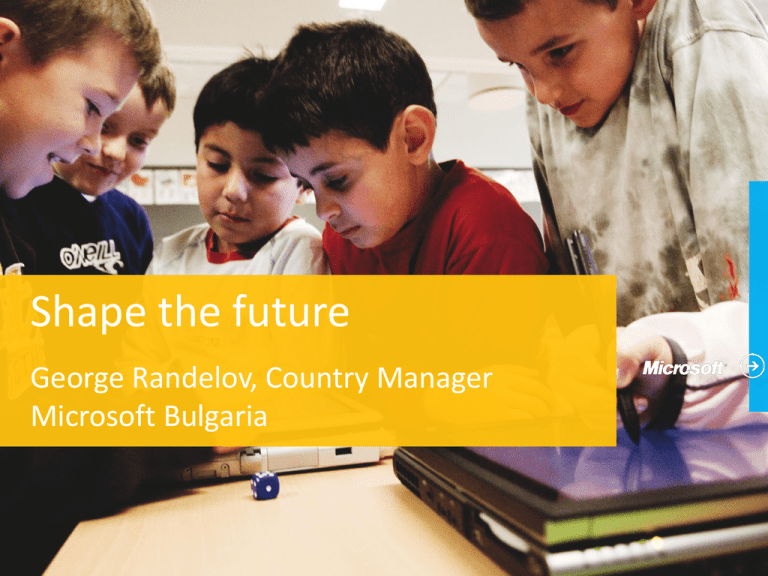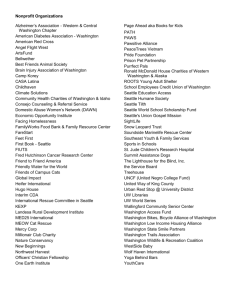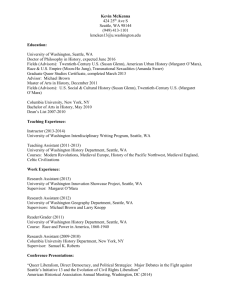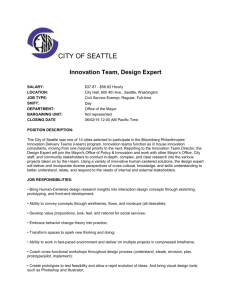Shape the Future, by George Randelov, General Manager of
advertisement

Shape the future George Randelov, Country Manager Microsoft Bulgaria - Bill Gates 2 Complex Challenges, New Opportunities Jobs & Economic Growth Empowering Youth with a Foundation for Future Innovation Key Societal Challenges Accelerating Economic Growth Empowering Youth 5 we help governments Creating More Jobs Education Improving Government Efficiency E-Government Entrepreneurs Shape the Future: 3 elements partnerships Identify, convene, support products Devices, software, connectivity, distribution programs Education, small business, egovernment SEATTLE’S ‘GREAT STUDENT’ INITIATIVE UPLIFTING CHILDREN & ELIMINATING THE DIGITAL DIVIDE Ensuring That All Seattle Students and their Families Can be a Part of the ‘Digital Society’ WHY: Home access to education technology creates jobs, drives economic growth and increases the city’s competitiveness HOW: By reducing digital exclusion among students and their families to tackle some of the city’s most pressing challenges WHAT: A public/private partnership to deliver broadband, PC, training and city services to digitally excluded Seattle families From Vision to Outcomes • Seattle can announce that every public school family can receive a world class education through the city’s commitment to digital inclusion for all students – and Seattle will lead the nation in this effort • The cost to a family will vary by their economic ability – and be tied to Free Lunch eligibility with subsidies & financing making the program accessible to all • A partnership between public, private and non-profit organizations will create a more affordable solution, with higher relevance, training and support and with greater accessibility to all Seattle families • Seattle will serve as a national model for developing smart and sustainable digital inclusion initiatives that can enable all US cities and all citizens to participate in the digital society Who Will Benefit? Students, Parents & Educators – and Seattle • Parental involvement can be increased through the effective use of technology in teaching and learning • Educators can more efficiently communicate with parents and students using technology • Addressing the ‘Digitally Excluded’ unlocks Seattle Public Schools’ existing technology, content and learning investments so that all students can use them • ‘Digitally Excluded’ students can end up creating a ‘Multiplier Effect’ of issues the City ultimately has to take responsibility for: • • • • • • More likely to drop out of school More likely to have encounters with law enforcement More likely to have significant and long term social support needs More likely to have parents who need workforce training assistance More likely to require unemployment benefits More likely to need local e-Services… and least likely to be able to access them 5 Key Steps to Developing a Solution Deliver, Support & Measure Map to the Policy Identify the Solutions Create the Program Build the Partnerships What is the impact? Social, economic and competitive – while transcending education • • • Access to quality education becomes a fundamental right, not a privilege for all Americans • • Skilled workforces create competitive advantages for states and cities Technology can enable equity for the underserved and disadvantaged Having a digitally literate community improves economic opportunities, social engagements and builds stronger tax bases through higher-paying jobs Public Private Partnerships can be directed to any audience that can make an impact in a city’s efficiencies, level of service or policies for inclusion: • Education: Providing teachers, families and students with access to PCs to enable home and school use through subsidized purchases of technology • Entrepreneurs: Helping entrepreneurs gain access to affordable technology and training which can increase their productivity and contribution to the local economy • eGovernment: Helping state and city government agencies ensure that citizens have the necessary technology to access online solutions • eHealth: Building digital skills and access for public health professionals while improving citizen access to health information and services • Seniors: Helping aging citizens become comfortable with technology so that they can access government health benefits, find new learning opportunities, maintain independent living, and connect with extended family and friends CMS Investment Study Group Report: Project L.I.F.T. (Leadership & Investment For Transformation) Average yearly earnings Bottom Line: The more you learn, the more you earn • Avg. college grad will earn $1M more over their lifetime compared to a high school dropout! • Over $60K in lost North Carolina taxes per dropout over their lifetime Education = Employment = Opportunity Unemployment Rate High school dropouts today have 3.5x the unemployment rate of college graduates 92 93 94 95 96 97 98 99 00 01 02 03 04 05 06 07 08 09 Proposed 5 Year Investments Investment Area Per Year 5 Year Total Talent $2.3M $11.5M Time $6.0M $30.0M $.6M $3.0M Community Support $1.6M $8.0M School Environment Enhancements In-kind In-kind $.5M $2.5M $11.0M $55.0M Technology Management Total Investment *Average. incremental resources per student/per year: ~$1500











